
Bibel und Exegese in der Abtei Sankt Viktor zu Paris
Form und Funktion eines Grundtextes im europäischen Rahmen
Der vorliegende Band über„Bibel und Exegese“ dokumentiert die Ergebnisse der Mainzer Tagung des Frankfurter Hugo von Sankt Viktor-Instituts im Jahre 2004. Durch dieses Symposium sind die Kenntnisse über die Abtei Sankt Viktor vertieft worden, indem das bisherige Bild von den Viktorinern in neue, den Ursprungsraum und die Anfangszeit überschreitende Zusammenhänge eingebettet worden ist. Das Nachleben patristischer Exegese in den Schriften der Viktoriner Autoren sowie deren genuine Intentionen (methodischer, literarischer, theologischer Natur) werden in den einzelnen Beiträgen exemplarisch verdeutlicht. Die Kultur des 12. bis 15. Jahrhunderts in ihren religiösen, künstlerischen und rechtlich-politischen Manifestationen zeigt einige ihrer Facetten im Spiegel des weit über Paris hinaus wirkenden viktorinischen Mikrokosmos.
This volume on „Bible and exegesis“ represents the results of the 2004 Mainz conference of Hugo of Saint Victor Institute. Due to this symposium knowledge about the abbey of Saint Victor could be enlarged by embedding the traditional image of the Victorians into new contexts that went beyond the time and place of origin. The Nachleben of patristic exegesis in the writings of the Victorian writers as well as their genuine intentions (methodological, literary, theological) is displayed in the individual contributions to the volume. 12th to 15th-century culture in its religious, artistic and legal-political manifestations shows some of its facets as mirrored in the Victorian microcosm, which was influential far beyond the boundaries of Paris.
Le présent volume sur „Bible et exégèse“ regroupe les contributions issus d=un colloque, organisé par l=Institut Hugues de Saint-Victor, qui s=est tenu à Mayence. Grâce à ce symposium, nos connaissances sur l=abbaye Saint-Victor se sont approfondies parce que la représentation que l=on s=en était faite jusqu=aujourd=hui a pu être rétablie dans des contextes nouveaux. Or, ceux-ci dépassent largement l=espace et le temps originels de l=abbaye parisienne. La postérité de l=exégèse patristique dans les écrits des auteurs victorins ainsi que leurs intuitions primaires (de nature méthodique, littéraire, et théologique) ont été mises en relief dans les travaux de ce volume. A travers de ses manifestations religieuses, artistiques et juridico-politiques, la culture médiévale laisse alors apparaître ses traits spécifiques, bien au-delà du microcosme victorin.






